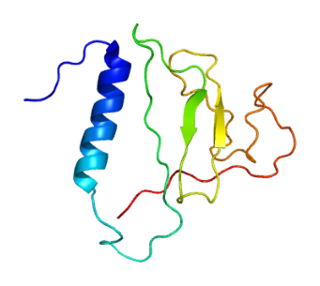
Androgen insensitivity syndrome (AIS) is a difference in sex development involving hormonal resistance due to androgen receptor dysfunction.
In medicine, precocious puberty is puberty occurring at an unusually early age. In most cases, the process is normal in every aspect except the unusually early age and simply represents a variation of normal development. In a minority of children with precocious puberty, the early development is triggered by a disease such as a tumor or injury of the brain. Even when there is no disease, unusually early puberty can have adverse effects on social behavior and psychological development, can reduce adult height potential, and may shift some lifelong health risks. Central precocious puberty can be treated by suppressing the pituitary hormones that induce sex steroid production. The opposite condition is delayed puberty.
X-linked adrenal hypoplasia congenita is a genetic disorder that mainly affects males. It involves many endocrine tissues in the body, especially the adrenal glands.

Partial androgen insensitivity syndrome (PAIS) is a condition that results in the partial inability of the cell to respond to androgens. It is an X linked recessive condition. The partial unresponsiveness of the cell to the presence of androgenic hormones impairs the masculinization of male genitalia in the developing fetus, as well as the development of male secondary sexual characteristics at puberty, but does not significantly impair female genital or sexual development. As such, the insensitivity to androgens is clinically significant only when it occurs in individuals with a Y chromosome. Clinical features include ambiguous genitalia at birth and primary amenhorrhoea with clitoromegaly with inguinal masses. Mullerian structures are not present in the individual.

Steroid 11β-hydroxylase, also known as steroid 11β-monooxygenase, is a steroid hydroxylase found in the zona glomerulosa and zona fasciculata of the adrenal cortex. Named officially the cytochrome P450 11B1, mitochondrial, it is a protein that in humans is encoded by the CYP11B1 gene. The enzyme is involved in the biosynthesis of adrenal corticosteroids by catalyzing the addition of hydroxyl groups during oxidation reactions.

Homeobox expressed in ES cells 1, also known as homeobox protein ANF, is a homeobox protein that in humans is encoded by the HESX1 gene.

Gonadotropin-releasing hormone receptor is a protein that in humans is encoded by the GNRHR gene.

The human gene SRD5A2 encodes the 3-oxo-5α-steroid 4-dehydrogenase 2 enzyme, also known as 5α-reductase type 2 (5αR2), one of three isozymes of 5α-reductase.

Insulin-like growth factor-binding protein 2 is a protein that in humans is encoded by the IGFBP2 gene.

Thyroid hormone receptor beta (TR-beta) also known as nuclear receptor subfamily 1, group A, member 2 (NR1A2), is a nuclear receptor protein that in humans is encoded by the THRB gene.

Relaxin/insulin-like family peptide receptor 2, also known as RXFP2, is a human G-protein coupled receptor.

Homeobox protein prophet of PIT-1 is a protein that in humans is encoded by the PROP1 gene.

Insulin-like growth factor binding protein, acid labile subunit, also known as IGFALS, is a protein which in humans is encoded by the IGFALS gene.

Seipin is a protein that in humans is encoded by the BSCL2 gene.

Chorion-specific transcription factor GCMb is a protein that in humans is encoded by the GCM2 gene.

Thyroid stimulating hormone, beta also known as TSHB is a protein which in humans is encoded by the TSHB gene.

Mild androgen insensitivity syndrome (MAIS) is a condition that results in a mild impairment of the cell's ability to respond to androgens. The degree of impairment is sufficient to impair spermatogenesis and / or the development of secondary sexual characteristics at puberty in males, but does not affect genital differentiation or development. Female genital and sexual development is not significantly affected by the insensitivity to androgens; as such, MAIS is only diagnosed in males. The clinical phenotype associated with MAIS is a normal male habitus with mild spermatogenic defect and / or reduced secondary terminal hair.

Synaptonemal complex central element protein 1 is a protein that in humans is encoded by the SYCE1 gene.

To date, at least 25 different genes have been implicated in causing gonadotropin-releasing hormone (GnRH) deficiency conditions such as Kallmann syndrome (KS) or other forms of congenital hypogonadotropic hypogonadism (CHH) through a disruption in the production or activity of GnRH. These genes involved cover all forms of inheritance, and no one gene defect has been shown to be common to all cases, which makes genetic testing and inheritance prediction difficult.

Steroidogenic acute regulatory protein is a protein that in humans is encoded by the STAR gene.


















